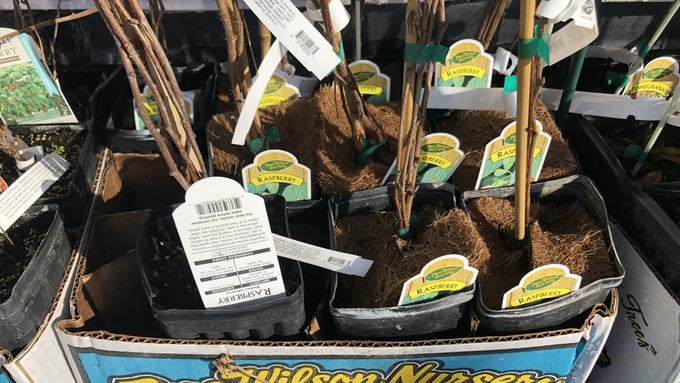
Fruit trees, roses, berries and more available 'naked' and ready to plant

These are raspberry bushes, packed in sleeves for bare-root planting. Many other types of berries, plus fruit trees and roses, are available this time of year as bare-root plants. Kathy Morrison
They look funny (because we’re not used to naked roots) and kind of counterintuitive (don’t plants need soil to live?), but they may be the best garden bargains you’ll find all year.
It’s bare-root season, which means nurseries are sporting sawdust-filled bins packed with dormant trees, shrubs and perennials. That sawdust helps protect those naked roots and keep them moist while the plants are out of the ground and “sleeping.”
Bare-root season allows growers and retail nurseries to save money, and some of those savings are passed onto buyers. Fruit trees, roses and other shrubs are dug up from growing fields in fall, then chilled in temperature-controlled warehouses; that pushes them into dormancy while keeping them fresh. They chill until they’re ready to ship to customers in winter.
Before or after shipping, growers and nurseries don’t have to repot bare-root stock. That saves on shipping costs (a bare-root fruit tree weighs a fraction of a tree in a pot full of soil) as well as time and labor.
The real bonuses are for the buyer. So much of a plant’s potential garden success is dependent on strong roots and here’s an opportunity to check them out. If bought in person, the plant can be inspected from top to bottom. Ideally, choose a tree or shrub with multiple, undamaged roots.
Another plus: Bare-root plants acclimate much faster than similar plants, transplanted from pots. Those naked roots can’t wait to get growing in their new surroundings. That gives the plant a head start on getting established (key to drought survival).
In addition, customers get more plant for their money. Bare-root fruit trees and roses are usually at least 3 years old; they’re mature plants. If bought in a pot, they’d cost significantly more.
Selection – especially of fruit trees, berries or roses – is never better than bare-root season. Nurseries don’t have physical space to keep lots of different varieties in stock in pots. But bare-root season allows for a full spectrum of varieties including many not available at any other time of year.
For fruit lovers, bare-root season is time to create your own diverse orchard or add favorites to your landscape. Among the fruit and nut trees available bare root: almond, apple, apricot, aprium, cherry, fig, jujube, mulberry, peach, pear, persimmon, plum, pluot and walnuts. This is also the time to find “fruit basket” trees with multiple varieties grafted onto the same trunk.
Both wine and table grapes are available bare root as well as many kinds of berries including blueberry, blackberry, boysenberry, currant, strawberry and raspberry. Perennial food plants such as horseradish and rhubarb are sold bare root, too.
Before transplanting, remember to give your new bare-root plant a drink. It can become dehydrated after so many weeks out of the ground. Soak the plant’s roots in a bucket or tub of water overnight.
For tips on selecting bare-root roses: https://bit.ly/3GlSuLb
Comments
0 comments have been posted.Sacramento Digs Gardening to your inbox.
Food in My Back Yard Series
May 6: Maintain soil moisture with mulch for garden success
April 29: What's (already) wrong with my tomato plants?
April 22: Should you stock up on fertilizer? (Yes!)
April 15: Grow culinary herbs in containers
April 8: When to plant summer vegetables
April 1: Don't be fooled by these garden myths
March 25: Fertilizer tips: How to 'feed' your vegetables for healthy growth
March 18: Time to give vegetable seedlings some more space
March 11: Ways to win the fight against weeds
March 4: Potatoes from the garden
Feb. 25: Plant a fruit tree now -- for later
Feb. 18: How to squeeze more food into less space
Feb. 11: When to plant? Consider staggering your transplants
Feb. 4: Starting in seed starting
Sites We Like
Garden Checklist for week of May 11
Make the most of the lower temperatures early in the week. We’ll be back in the 80s by Thursday.
* Plant, plant, plant! It’s prime planting season in the Sacramento area. Time to set out those tomato transplants along with peppers and eggplants. Pinch off any flowers on new transplants to make them concentrate on establishing roots instead of setting premature fruit.
* Direct-seed melons, cucumbers, summer squash, corn, radishes, pumpkins and annual herbs such as basil.
* Harvest cabbage, lettuce, peas and green onions.
* In the flower garden, direct-seed sunflowers, cosmos, salvia, zinnias, marigolds, celosia and asters. (You also can transplant seedlings for many of the same flowers.)
* Plant dahlia tubers.
* Transplant petunias, marigolds and perennial flowers such as astilbe, columbine, coneflowers, coreopsis, dahlias, rudbeckia and verbena.
* Keep an eye out for slugs, snails, earwigs and aphids that want to dine on tender new growth.
* Feed summer bloomers with a balanced fertilizer.
* For continued bloom, cut off spent flowers on roses as well as other flowering plants.
* Add mulch to the garden to maintain moisture. Mulch also cuts down on weeds. But don’t let it mound around the stems or trunks of trees or shrubs. Leave about a 6-inch-to-1-foot circle to avoid crown rot or other problems.
* Remember to weed! Pull those nasties before they set seed.
* Water early in the day and keep seedlings evenly moist.